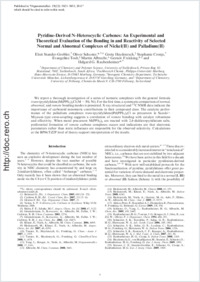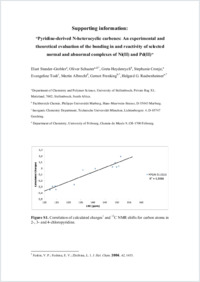Pyridine-derived N-heterocyclic carbenes: an experimental and theoretical evaluation of the bonding in and reactivity of selected normal and abnormal complexes of nickel(II) and palladium(II)
- Stander-Grobler, Elzet Department of Chemistry and Polymer Science, University of Stellenbosch, South Africa
- Schuster, Oliver Department of Chemistry and Polymer Science, University of Stellenbosch, South Africa - Department of Chemistry, University of Fribourg, Switzerland
- Heydenrych, Greta Fachbereich Chemie, Philipps-Universitt Marburg, Germany
- Cronje, Stephanie Department of Chemistry and Polymer Science, University of Stellenbosch, South Africa
- Tosh, Evangeline Inorganic Chemistry Department, Technische Universität München, Garching, Germany
- Albrecht, Martin Department of Chemistry, University of Fribourg, Switzerland
- Frenking, Gernot Fachbereich Chemie, Philipps-Universitt Marburg, Germany
- Raubenheimer, Helgard G. Department of Chemistry and Polymer Science, University of Stellenbosch, South Africa
-
22.10.2010
Published in:
- Organometallics. - 2011, vol. 29, no. 22, p. 5821–5833
English
We report a thorough investigation of a series of isomeric complexes with the general formula trans-(pyridylidene)M(PPh₃)₂Cl (M = Pd, Ni). For the first time, a systematic comparison of normal, abnormal, and remote bonding modes is presented. X-ray structural and ¹³C NMR data indicate the importance of carbenoid mesomeric contributions in their compound class. The catalytic performance of the palladium complexes trans-(pyridylidene)Pd(PPh₃)₂Cl as precursors in Suzuki−Miyaura-type cross-coupling suggests a correlation of remote bonding with catalyst robustness and effectivity. When metal precursors M(PPh₃)₄ are reacted with 2,4-dichloropyridinium salts, preferential formation of remote carbene complexes occurs and indications are that electronic parameters rather than steric influences are responsible for the observed selectivity. Calculations at the BP86/TZ2P level of theory support interpretation of the results.
- Faculty
- Faculté des sciences et de médecine
- Department
- Département de Chimie
- Language
-
- English
- Classification
- Chemistry
- License
-
License undefined
- Identifiers
-
- RERO DOC 22503
- DOI 10.1021/om100431u
- Persistent URL
- https://folia.unifr.ch/unifr/documents/301778
Other files
Statistics
Document views: 104
File downloads:
- pdf: 244
- Supplementary material: 126
- Supplementary material CIF: 75


